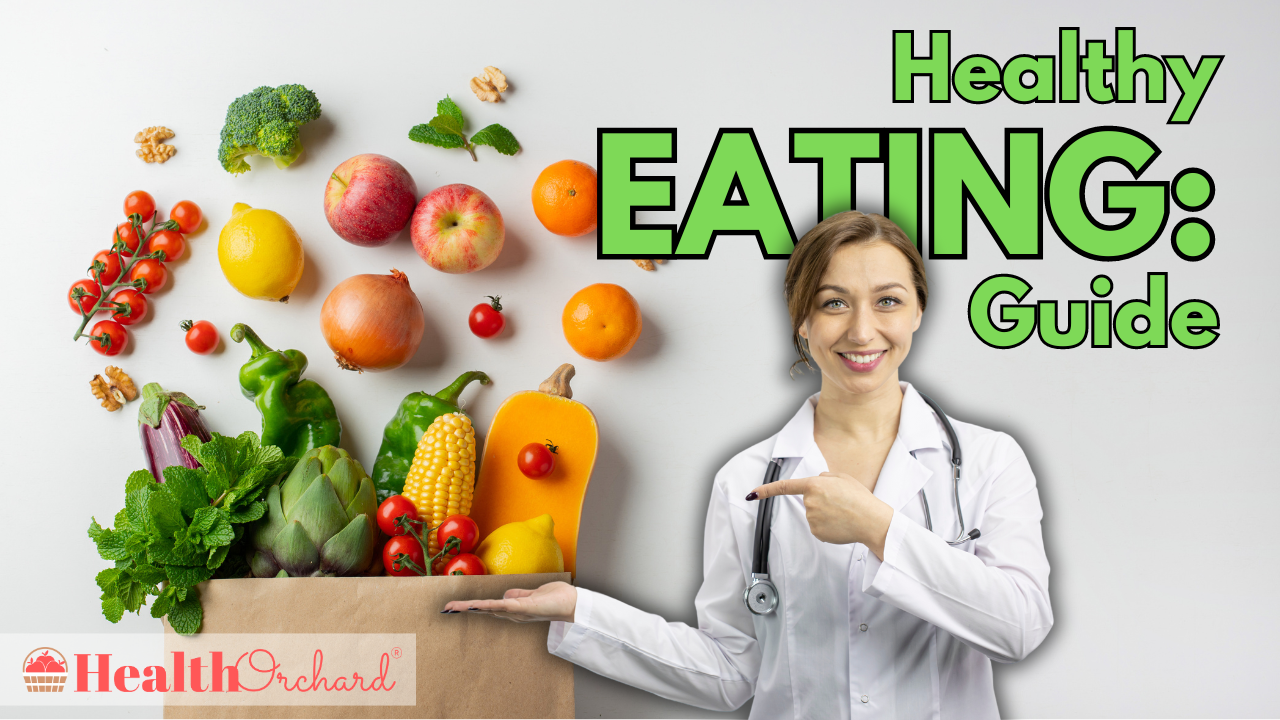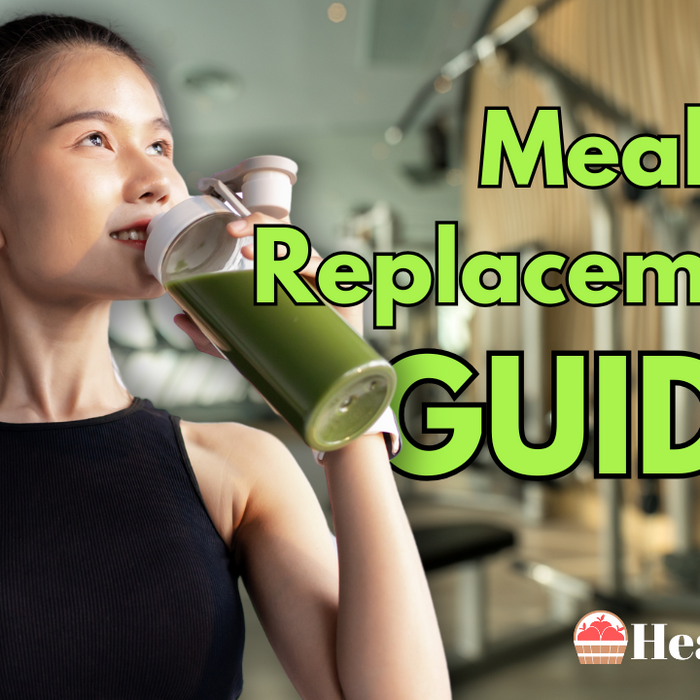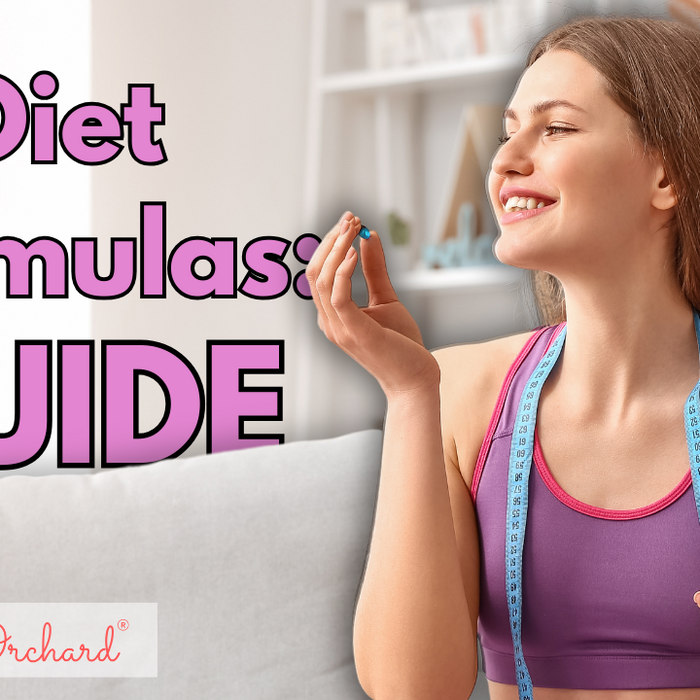

Healthy Eating: Guide
Key Takeaways
- Eat a Balanced Diet: Focus on including carbohydrates, proteins, fats, vitamins, and minerals to support your health.
- Boost Your Health: A balanced diet helps control weight, reduces the risk of chronic diseases, and improves overall well-being.
- Plan Diverse Meals: Include fruits, vegetables, whole grains, lean proteins, and healthy fats in your meals. Control portions and vary your food choices.
- Prepare and Cook Smart: Plan meals in advance, check food labels, and use healthy cooking methods like grilling and steaming. Cut down on salt, sugar, and unhealthy fats.
- Use Supplements to Improve Nutrient Intake: Take vitamins and supplements to fill nutritional gaps or support specific health needs.
- Adjust for Special Diets: Meet the needs of vegetarian, vegan, or gluten-free diets by choosing a variety of nutritious and fortified foods.
- Build Healthy Habits: Manage cravings with mindful eating, stick to a budget-friendly healthy diet, and make smart food choices when eating out or traveling. Exercise regularly and get enough sleep.
Let's face it: with all the conflicting nutrition advice out there, figuring out how to eat healthy can feel like solving a Rubik's cube blindfolded. But don't worry – eating well doesn't have to be complicated. This guide will cut through the noise and give you practical, science-backed tips to nourish your body and feel your best.
Why Healthy Eating Matters
First, let's talk about why healthy eating is so important. Food isn't just fuel – it's information for your body. The nutrients you consume affect everything from your energy levels and mood to your long-term health and disease risk.
The benefits of healthy eating include:
Physical health benefits
Weight management: A balanced diet helps maintain a healthy weight by providing appropriate portions and nutrient-dense foods.
Reduced risk of chronic diseases: Eating a variety of nutrient-rich foods can reduce the risk of heart disease, diabetes, and certain cancers.
Improved digestion and gut health: A diet high in fiber from fruits, vegetables, and whole grains supports healthy digestion and a diverse gut microbiome.
Mental health benefits
Enhanced mood and energy levels: Nutrient-rich foods can improve mood and energy, reducing the risk of depression and fatigue.
Better cognitive function: Nutrients like omega-3 fatty acids and antioxidants support brain health and cognitive function.
Long-term benefits for overall well-being
Adopting healthy eating habits contributes to a longer, healthier life with improved quality of life and reduced healthcare costs.
Conversely, a poor diet, such as a diet high in ultra-processed foods, is associated with increased health risks and mortality. The good news? Small, sustainable changes to your eating habits can make a big difference.
What Does Healthy Eating Mean?
Healthy eating means consuming a diverse range of foods that provide essential nutrients your body needs for optimal functioning, energy, and overall well-being. This includes a balance of macronutrients (carbohydrates, proteins, and fats) and micronutrients (vitamins and minerals) from sources like fruits, vegetables, whole grains, lean proteins, and healthy fats.
At its core, healthy eating is about nourishing your body with nutrient-dense foods while practicing moderation and mindfulness. It's not about strict diets or eliminating entire food groups, but rather making informed choices that support your health goals. This approach emphasizes whole, minimally processed foods, portion control, and staying hydrated, while also allowing for flexibility and enjoyment in your eating habits.
The Basics of Healthy Eating
Forget about fad diets and restrictive eating plans. Healthy eating is about nourishing your body with a variety of nutrient-dense foods. Here are the basics of healthy eating to keep in mind:
Focus on Nutrient Density
Not all calories are created equal. Nutrient density refers to the amount of beneficial nutrients a food provides relative to its calorie content. Nutrient-dense foods give you more nutritional bang for your buck.
Examples of nutrient-dense foods:
- Leafy greens
- Berries
- Nuts and seeds
- Fatty fish
- Eggs
- Legumes
Aim to fill your plate with these nutritional powerhouses.
Embrace Variety
Eating a diverse diet ensures you get a wide range of nutrients and promotes a healthy gut microbiome. Try to include different colors, textures, and food groups in your meals.
Don't Fear Macronutrients
Carbs, fats, and proteins all play important roles in your body. Instead of cutting out entire food groups, focus on choosing high-quality sources of each:
- Carbs: Whole grains, fruits, vegetables, legumes
- Fats: Avocados, nuts, seeds, olive oil, fatty fish
- Proteins: Lean meats, fish, eggs, legumes, tofu
Limit Ultra-Processed Foods
While you don't need to completely eliminate treats, it's best to minimize foods high in added sugars, unhealthy fats, and artificial ingredients. These often provide empty calories with little nutritional value.
Essential Nutrients for Healthy Eating
The foundation of a healthy diet lies in consuming a balanced mix of essential nutrients. These vital compounds fuel our bodies, support growth and repair, and maintain overall health. Understanding these nutrients and their roles can help you make informed choices about your diet and ensure you're giving your body what it needs to thrive.
What are Essential Nutrients?
Essential nutrients are substances your body needs to function effectively but cannot produce on its own. These nutrients must be obtained through your diet and include macronutrients and micronutrients.
Macronutrients: Carbohydrates, Proteins, and Fats
Macronutrients are nutrients that your body requires in larger amounts. They provide energy and are essential for growth, metabolism, and other bodily functions.
Carbohydrates
- Types: Simple vs. complex. Simple carbs are quickly absorbed and can spike blood sugar levels, while complex carbs are digested more slowly and provide sustained energy.
- Functions: Carbohydrates are the body's primary energy source, essential for brain function and physical activity.
- Healthy sources: Whole grains, fruits, and vegetables. These provide fiber, vitamins, and minerals along with energy.
Proteins
- Types: Complete vs. incomplete. Complete proteins contain all essential amino acids, while incomplete proteins lack one or more essential amino acids.
- Functions: Proteins are crucial for building and repairing tissues, making enzymes and hormones, and supporting immune function.
- Healthy sources: Lean meats, beans, nuts, and dairy. Including a variety of protein sources ensures you get all essential amino acids.
Fats
- Types: Saturated, unsaturated, and trans fats. Unsaturated fats (found in avocados, nuts, and fish) are beneficial, while trans fats (found in some processed foods) should be avoided.
- Functions: Fats provide energy, support cell growth, protect organs, and help absorb vitamins.
- Healthy sources: Avocados, nuts, seeds, and fish. These sources provide essential fatty acids and other nutrients.
Micronutrients: Vitamins and Minerals
Micronutrients are nutrients your body needs in smaller amounts. They are crucial for various physiological functions, including immune response, bone health, and cellular processes.
Essential Vitamins
- Vitamin A: Supports vision, immune function, and skin health. Found in carrots, sweet potatoes, and leafy greens.
- Vitamin C: Acts as an antioxidant, supports the immune system, and promotes skin health. Found in citrus fruits, strawberries, and bell peppers.
- Vitamin D: Essential for bone health and immune function. Found in fortified dairy products, fatty fish, and from sunlight exposure.
Essential Minerals
- Calcium: Crucial for bone health, muscle function, and nerve signaling. Found in dairy products, leafy greens, and fortified foods.
- Iron: Necessary for oxygen transport in the blood. Found in red meat, beans, and fortified cereals.
- Magnesium: Supports muscle and nerve function, energy production, and bone health. Found in nuts, seeds, and whole grains.
Water and Hydration
Water is vital for every cell, tissue, and organ in your body. It helps regulate temperature, lubricate joints, transport nutrients, and remove waste. Aim to drink at least 8 glasses of water a day, more if you are active or in a hot climate.
Common Myths and Misconceptions about Healthy Eating
There are many myths when it comes to what you should be eating, here are the top three most popular myths about healthy eating:
Myth #1: Carbs are bad for you.
Fact: Carbohydrates are a primary energy source. The key is choosing complex carbs like whole grains over simple carbs like sugary snacks.
Myth #2: Fat-free means healthy.
Fact: Some fats are essential for health. Focus on healthy fats from sources like avocados and nuts rather than avoiding fats altogether.
Myth #3: Skipping meals can help with weight loss.
Fact: Skipping meals can lead to overeating later and a slower metabolism. Regular, balanced meals are more effective for weight management.
24 Principles of Healthy Eating
Now that you’re familiar with the key components of a healthy diet and some of the most common myths, let’s review the top 24 principles and rules of healthy eating you should live by. By following key principles, you can create a balanced, nutritious diet that supports overall health and well-being.
1. Eat lots of vegetables
Include a variety of vegetables in your meals every day. Aim for a rainbow of colors to ensure you get a wide range of nutrients.
2. Limit sugar intake
Reduce the amount of added sugars in your diet. Opt for natural sweeteners and limit sugary snacks and desserts.
3. Balance your diet
Ensure your diet includes the right proportions of carbohydrates, proteins, and fats to support overall health and bodily functions.
4. Include dairy products
Consume low-fat or fat-free dairy products, or fortified plant-based alternatives, to meet your calcium and vitamin D needs.
5. Drink plenty of water
Stay hydrated by drinking plenty of water throughout the day. Aim for at least 8 glasses daily, more if you are active.
6. Eat a variety of foods
Incorporate a wide range of foods in your diet to ensure you get all necessary nutrients. This includes different fruits, vegetables, grains, and proteins.
7. Choose healthy fats
Include sources of healthy fats, such as avocados, nuts, seeds, and fish, in your diet. Limit saturated and trans fats.
8. Limit sugary drinks
Reduce the consumption of sugary beverages like sodas, energy drinks, and sweetened coffees. Opt for water, herbal teas, or natural juices instead.
9. Avoid processed meats
Minimize the intake of processed meats like sausages, bacon, and deli meats. Choose lean cuts of fresh meat and poultry.
10. Balance macronutrients
Ensure your meals contain a balanced mix of carbohydrates, proteins, and fats to maintain energy levels and support bodily functions.
11. Control calories
Monitor your calorie intake to maintain a healthy weight. Eat mindfully and avoid overeating.
12. Choose whole grains
Opt for whole grain foods like brown rice, quinoa, and whole-wheat bread instead of refined grains. Whole grains are higher in fiber and nutrients.
13. Eat less salt
Reduce your salt intake by limiting processed foods and using herbs and spices for flavoring. Aim for less than 2300 mg of sodium per day.
14. Eat regular meals and snacks
Maintain a consistent eating schedule with regular meals and healthy snacks to keep your metabolism steady and prevent overeating.
15. Eat fruits
Incorporate a variety of fruits into your diet for vitamins, minerals, and fiber. Fresh, frozen, or canned (without added sugar) are all good options.
16. Include grains
Eat a variety of grains, including whole grains, to provide energy and essential nutrients.
17. Have variety in your diet
Ensure your diet includes a wide range of different foods to get a broad spectrum of nutrients and avoid dietary monotony.
18. Include fermented foods
Add fermented foods like yogurt, kefir, sauerkraut, and kimchi to your diet for probiotics, which support gut health.
19. Choose lean meats and poultry
Select lean cuts of meat and skinless poultry to reduce saturated fat intake. Grill, bake, or steam instead of frying.
20. Limit fat intake
While healthy fats are important, be mindful of the total amount of fat you consume. Focus on quality over quantity.
21. Limit processed foods
Minimize the consumption of processed foods, which are often high in unhealthy fats, sugars, and sodium.
22. Plan your meals
Develop a meal plan to ensure balanced and nutritious meals throughout the week. This helps avoid unhealthy last-minute food choices.
23. Practice moderation
Eat in moderation to maintain a healthy weight and prevent overconsumption of any particular food or nutrient.
24. Use oils and spreads wisely
Choose healthier options like olive oil and avocado spread, and use them sparingly to manage fat intake.
Creating a Plan for Healthy Eating
Creating a sustainable healthy eating plan involves more than just knowing what to eat—it's about developing habits that nourish your body while fitting your lifestyle. The tricky part is actually sticking to a diet that incorporates all of the above key principles. Start by creating a plan that simply focuses on incorporating a variety of food groups, controlling portion sizes, and practicing moderation.
Use the following tips to help build a basic meal plan for eating healthy:
Understand the Main Food Groups
A balanced diet incorporates a variety of foods from all major groups:
- Fruits and Vegetables: Aim for a colorful array to ensure a wide range of vitamins, minerals, and antioxidants. Different colors often indicate different nutritional benefits.
- Whole Grains: Choose options like brown rice, quinoa, and whole-wheat bread for fiber, vitamins, and minerals. These support digestive health and provide sustained energy.
- Lean Proteins: Include sources such as chicken, fish, beans, and tofu to get essential amino acids crucial for muscle repair and immune function.
- Healthy Fats: Incorporate avocados, nuts, seeds, and olive oil. These fats are vital for brain health, hormone production, and vitamin absorption.
- Dairy or Alternatives: Opt for low-fat dairy or fortified plant-based alternatives to ensure adequate calcium and vitamin D intake for bone health.
Master Portion Control
Understanding portion sizes is key to preventing overeating and ensuring balanced nutrition. Use these visual cues:
- Protein: Palm-sized portion
- Vegetables: Fist-sized serving
- Grains: Cupped handful
- Fats: Thumb-sized amount
These guides help maintain balance without the need for strict calorie counting.
Embrace Variety and Moderation
Eating a diverse range of foods not only makes meals more enjoyable but also reduces the risk of nutritional deficiencies. Practice moderation to prevent overconsumption of any single food or nutrient, which can lead to imbalances.
Example Healthy Eating Plans
Creating a structured healthy eating plan can help you implement the principles of balanced nutrition into your daily life. Here are two example plans: one for a typical weekday and another for a weekend day.
Weekday Healthy Eating Plan
Breakfast
- Spinach and Mushroom Omelette: Two eggs, a handful of spinach, and sliced mushrooms cooked in a small amount of olive oil.
- Whole Grain Toast: One slice of whole-grain toast.
- Fruit: A small bowl of mixed berries (strawberries, blueberries, and raspberries).
Mid-Morning Snack
- Greek Yogurt with Honey: One cup of plain Greek yogurt drizzled with a teaspoon of honey.
- Nuts: A small handful of almonds or walnuts.
Lunch
- Quinoa Salad: Quinoa mixed with chickpeas, cherry tomatoes, cucumber, red onion, and a light vinaigrette dressing.
- Grilled Chicken Breast: A small, grilled chicken breast seasoned with herbs.
- Apple: One medium apple.
Afternoon Snack
- Vegetable Sticks with Hummus: Carrot and celery sticks with a serving of hummus.
Dinner
- Grilled Salmon: A portion of grilled salmon with lemon and dill.
- Brown Rice: A serving of brown rice.
- Steamed Broccoli: A side of steamed broccoli drizzled with a little olive oil and sprinkled with sesame seeds.
Evening Snack
- Herbal Tea: A cup of herbal tea, such as chamomile or peppermint.
- Dark Chocolate: A small piece of dark chocolate (70% cocoa or higher).
Weekend Healthy Eating Plan
Breakfast
- Overnight Oats: Rolled oats soaked overnight in almond milk, topped with chia seeds, sliced banana, and a handful of blueberries.
- Smoothie: A green smoothie made with spinach, avocado, a small apple, and a splash of coconut water.
Mid-Morning Snack
- Fruit and Nut Mix: A mix of dried apricots, raisins, and unsalted nuts.
Lunch
- Veggie Wrap: Whole wheat wrap filled with hummus, roasted red peppers, shredded lettuce, and grated carrots.
- Side Salad: Mixed greens with cherry tomatoes, cucumber, and a light olive oil dressing.
Afternoon Snack
- Rice Cakes with Avocado: Two brown rice cakes topped with mashed avocado, a sprinkle of salt, and a dash of lemon juice.
Dinner
- Stir-Fry: Tofu stir-fried with a variety of vegetables (bell peppers, snap peas, carrots, and bok choy) in a low-sodium soy sauce.
- Brown Rice or Quinoa: A serving of brown rice or quinoa.
Evening Snack
- Popcorn: Air-popped popcorn with a sprinkle of nutritional yeast for a cheesy flavor.
- Herbal Tea: A calming herbal tea, such as rooibos or chamomile.
Tips for Customizing Your Healthy Eating Plan
- Adjust Portions: Based on your individual calorie needs, adjust the portion sizes accordingly.
- Mix and Match: Feel free to swap meals and snacks between the plans or customize them with your favorite healthy ingredients.
- Prepare in Advance: Utilize batch cooking and meal prep techniques to save time and ensure you have healthy options readily available.
- Stay Hydrated: Drink plenty of water throughout the day, aiming for at least 8 glasses.
How to Stick to a Healthy Eating Routine
Creating a sustainable healthy eating routine involves thoughtful planning, smart shopping, and effective cooking methods. Here’s how to get started:
Plan and Prepare Your Meals
Meal Planning Strategies: Plan your meals and snacks for the week to ensure a balanced diet and avoid unhealthy choices. Use a meal planner or app, like Eat This Much or Mealime, to organize your meals, incorporating a variety of food groups to cover all essential nutrients.
Grocery Shopping Tips: Make a shopping list based on your meal plan. You can use apps like Flipp or AnyList to help create your own healthy shopping lists. Shop the perimeter of the store for fresh produce, lean proteins, and dairy, and avoid the center aisles where processed foods are typically found. This helps you stick to your healthy eating plan and resist unhealthy temptations.
Batch Cooking and Meal Prep Ideas: Prepare larger quantities of healthy meals and portion them out for the week. This not only saves time but also ensures you have nutritious options readily available. Cook a big pot of vegetable soup, roast a tray of mixed vegetables, or grill several chicken breasts to use in various dishes.
Read and Understand Food Labels
Key Information to Look For: When reading food labels, check the serving sizes, total calories, and the amount of nutrients per serving. Focus on foods that provide vitamins, minerals, and fiber, and be cautious of high levels of added sugars, sodium, and unhealthy fats.
Identifying Hidden Sugars and Unhealthy Ingredients: Be aware of common ingredients that indicate added sugars and unhealthy fats. Look for terms like high-fructose corn syrup, partially hydrogenated oils, and trans fats. Also, check for excessive sodium, which can often be hidden in processed foods.
Use Healthy Cooking Methods
Grilling, Steaming, Baking, and Sautéing: These cooking methods help preserve nutrients and avoid adding excess fats or calories. Steaming vegetables keeps their vitamins intact, and grilling meats can reduce the amount of fat.
Reducing Salt, Sugar, and Unhealthy Fats: Enhance flavor without relying on salt, sugar, or unhealthy fats by using herbs, spices, and natural sweeteners. Experiment with garlic, ginger, basil, cilantro, and other seasonings to make your meals both healthy and delicious. Use healthy fats like olive oil and avocado in moderation to add richness to your dishes.
Role of Vitamins and Supplements in Healthy Eating
While a well-rounded diet should ideally provide most nutrients, vitamins and supplements can help fill nutritional gaps, especially in certain circumstances.
When to Consider Supplements
Nutrient Deficiencies: If you have a deficiency confirmed by a healthcare professional, supplements can help fill the gap. For example, iron supplements can be crucial for those with iron-deficiency anemia, and vitamin D supplements can be essential for individuals with low levels due to limited sun exposure.
Specific Health Conditions: Certain conditions may increase nutrient needs or affect nutrient absorption, making supplements beneficial. For instance, individuals with celiac disease, Crohn’s disease, or other malabsorption issues may require additional vitamins and minerals.
Lifestyle Factors: Pregnancy, aging, and intense physical activity can increase nutrient requirements. Pregnant women often need more folic acid and iron, older adults may require more calcium and vitamin D to maintain bone health, and athletes might benefit from the best workout supplements, like protein powders and electrolyte supplements to support their increased activity levels.
Choosing the Right Supplements
Consulting with Healthcare Professionals: Always discuss supplement use with a healthcare provider to ensure safety and effectiveness. They can help determine which supplements are necessary based on your individual health needs and conditions.
Quality and Safety Considerations: Choose reputable brands like ALLMAX, NOW Foods, Thorne Research, Paradise Herbs, among many others. Look for brands that do third-party testing and certifications. This ensures the supplements are free from contaminants and contain the ingredients and dosages listed on the label.
Popular Supplements and Their Benefits
Multivitamins: Multivitamins provide a broad range of nutrients to support overall health, particularly useful for individuals who may not get enough nutrients from their diet alone.
Omega-3 Fatty Acids: Omega-3 pills support heart and brain health and reduce inflammation. These are commonly found in fish oil supplements and are beneficial for cardiovascular health and cognitive function.
Probiotics: Probiotics promote digestive health and support a healthy gut microbiome. They can help with conditions like irritable bowel syndrome (IBS) and improve overall gut health by balancing beneficial bacteria.
Health Orchard's Approach to Supplements
At Health Orchard, we provide high-quality, tested supplements to meet your health needs. Our comprehensive approach includes:
- Price Comparisons: We collect prices from top retailers to help you find the best deals.
- Quality Grading: Our supplements undergo rigorous testing for potency and heavy metals, receiving a Quality Grade (A-F) for transparency.
- Expert Advice: Watch videos from real doctors explaining each supplement's uses, benefits, and risks, ensuring you make informed decisions.
Shop supplements online to explore our wide range of health products and compare prices with ease.
Healthy Eating Special Considerations and Diets
Healthy eating can vary significantly based on individual dietary preferences, health conditions, and nutritional needs. Here are some key considerations for specific diets and conditions to ensure balanced and nutritious eating habits.
Vegetarian and Vegan Diets
Nutritional Considerations and Tips:
- Ensure Adequate Intake of Key Nutrients: Focus on getting enough protein, vitamin B12, iron, and calcium. These nutrients are crucial for maintaining health and are often found in animal products, so special attention is needed to include them in plant-based diets.
- Protein Sources: Include a variety of plant-based proteins such as beans, lentils, tofu, tempeh, nuts, and seeds. If necessary, consider protein supplements to meet your daily requirements.
- Vitamin B12: Since B12 is primarily found in animal products, it’s essential to consume fortified foods like plant-based milks and cereals or take a B12 supplement to support nerve function and red blood cell production.
- Iron: Plant-based iron sources include beans, lentils, and fortified cereals. To enhance iron absorption, pair these with vitamin C-rich foods like citrus fruits, tomatoes, and bell peppers.
Gluten-Free Diets
Understanding Gluten Sensitivity and Celiac Disease:
- Gluten-Free Necessity: A gluten-free diet is crucial for individuals with celiac disease or non-celiac gluten sensitivity to prevent adverse health effects.
- Gluten-Free Alternatives: Use naturally gluten-free grains such as rice, quinoa, and millet. Always check labels for gluten-free certification on processed foods to avoid accidental gluten intake.
Diets for Specific Health Conditions
Managing Diabetes Through Diet:
- Focus on Whole Grains and Lean Proteins: Choose whole grains, lean proteins, and non-starchy vegetables to manage blood sugar levels effectively.
- Monitor Carbohydrate Intake: Pay attention to carbohydrate content and choose low-glycemic foods like whole grains and legumes to stabilize blood sugar.
Heart-Healthy Eating Plans:
- Emphasize Nutrient-Dense Foods: Incorporate plenty of fruits, vegetables, whole grains, lean proteins, and healthy fats into your diet. These foods support cardiovascular health by providing essential nutrients and reducing cholesterol levels.
- Limit Unhealthy Fats and Sodium: Reduce intake of saturated fats, trans fats, and sodium. Opt for healthy fats from sources like olive oil, nuts, and avocados, and use herbs and spices to flavor food instead of salt.
Practical Tips for Special Diets
Vegetarian and Vegan Diets:
- Diversify Your Diet: Eat a wide range of plant-based foods to ensure you're getting all essential nutrients. Explore different cuisines to keep meals exciting and nutrient-rich.
- Regular Monitoring: Have regular blood tests to monitor levels of critical nutrients like B12, iron, and vitamin D, and adjust your diet or supplements accordingly.
Gluten-Free Diets:
- Read Labels Carefully: Gluten can be hidden in many processed foods, so always check ingredient lists for gluten-containing ingredients.
- Cook at Home: Preparing meals at home allows you to control ingredients and avoid cross-contamination with gluten.
Diabetes Management:
- Regular Meal Timing: Eat at regular intervals to maintain stable blood sugar levels. Include fiber-rich foods to slow down digestion and glucose absorption.
- Stay Hydrated: Drink plenty of water and avoid sugary beverages to help manage blood sugar levels.
Heart Health:
- Healthy Cooking Methods: Use methods like grilling, steaming, and baking instead of frying to reduce unhealthy fat intake.
- Portion Control: Be mindful of portion sizes to avoid overeating, which can contribute to weight gain and increased heart disease risk.
Overcoming Challenges to Healthy Eating
Dealing with cravings and emotional eating
Strategies to manage cravings: Identify triggers, keep healthy snacks on hand, and practice mindful eating.
Mindful eating practices: Focus on the taste, texture, and satisfaction of food, and avoid distractions while eating.
Eating healthy on a budget
Affordable healthy food options: Buy in bulk, choose seasonal produce, and look for sales and discounts.
Budget-friendly meal ideas: Plan simple meals with inexpensive ingredients like beans, lentils, and whole grains.
Maintaining healthy eating habits while traveling or dining out
Tips for making healthy choices at restaurants: Look for grilled, baked, or steamed options, and ask for dressings and sauces on the side.
Travel-friendly healthy snacks: Pack nuts, seeds, fruits, and whole-grain snacks to avoid unhealthy options.
Integrating Exercise and Lifestyle Changes
Importance of combining diet with physical activity
Regular physical activity and a good fitness routine complements a healthy diet by helping to maintain a healthy weight, reducing the risk of chronic diseases, and improving mental health.
Simple ways to incorporate exercise into your daily routine
Incorporate physical activity into your daily routine by taking short walks, using stairs instead of elevators, and finding activities you enjoy.
Other lifestyle factors
Sleep: Aim for 7-9 hours of sleep per night to support overall health.
Stress management: Practice relaxation techniques like deep breathing, meditation, and yoga to manage stress.
Ready to Boost Your Healthy Eating with Vitamins and Supplements?
Healthy eating is a lifelong journey that involves understanding the nutrients your body needs, enjoying the benefits of a balanced diet, and implementing practical tips into your daily routine.
Incorporating high-quality vitamins and supplements can fill nutritional gaps and improve your overall well-being. Health Orchard offers a wide range of the best vitamins and supplements online to meet your specific health needs.
Buy vitamins direct from Health Orchard, we make it easy to compare supplement prices from top sellers like Walmart, Amazon, iHerb, Walgreens, HerbsPro and more to ensure you’re getting the best price and the highest quality products. Make informed choices to support your healthy lifestyle.
Frequently Asked Questions about Healthy Eating
1. What is the most important aspect of healthy eating?
The most important aspect of healthy eating is prioritizing nutrient-dense foods while maintaining a balanced diet. This means choosing foods rich in vitamins, minerals, and other essential nutrients, such as fruits, vegetables, whole grains, lean proteins, and healthy fats. A balanced diet ensures you get the right mix of nutrients to support bodily functions, boost energy levels, and prevent chronic diseases.
2. How can I make healthy eating a habit?
Making healthy eating a habit starts with small, manageable changes. Begin by incorporating more fruits and vegetables into your meals, planning your meals ahead of time, and keeping healthy snacks like nuts or cut-up veggies on hand. Gradually replace processed foods with whole foods, and create a consistent meal schedule to help your body adjust to healthier options. Over time, these small changes will become part of your routine.
3. What are some quick and healthy meal ideas?
Quick and healthy meals can be simple and delicious. For breakfast, try a spinach and egg scramble, which is packed with protein and nutrients. For lunch, a sweet potato stuffed with roasted veggies and beans provides a balanced mix of carbs, fiber, and protein. Dinner can be a salmon fillet sautéed with broccoli and olive oil, offering healthy fats and essential vitamins. These meals are not only nutritious but also easy to prepare.
4. How can I ensure I'm getting all essential nutrients on a vegetarian/vegan diet?
To get all essential nutrients on a vegetarian or vegan diet, include a variety of plant-based protein sources such as beans, lentils, tofu, and quinoa. Fortified foods, like plant-based milk and cereals, can help provide vitamins B12 and D, calcium, and iron. Consider taking supplements if needed, especially for nutrients that are harder to obtain from plant sources alone. Consulting a dietitian can also help ensure your diet is well-rounded.
5. Are there any foods I should avoid completely?
It's not necessary to avoid any food completely, but it's wise to limit ultra-processed foods and sugary beverages. These items are often high in unhealthy fats, sugars, and sodium, which can contribute to various health issues if consumed in excess. Instead, focus on whole, nutrient-dense foods. Occasional treats are fine and can be enjoyed as part of a balanced diet, maintaining overall moderation.
6. How do I read food labels effectively?
Reading food labels effectively involves checking the serving size, total calories, and nutrients per serving. Pay attention to the amounts of added sugars, sodium, and unhealthy fats. Look for foods high in fiber, vitamins, and minerals, and be wary of ingredients lists with long, unrecognizable items. Understanding these details can help you make healthier choices and avoid deceptive marketing claims.
7. What are some strategies for healthy eating on a tight budget?
Eating healthy on a tight budget is possible by buying in bulk, choosing seasonal produce, and planning simple meals. Bulk purchases of staples like beans, lentils, and whole grains are cost-effective. Seasonal fruits and vegetables are often cheaper and fresher. Planning meals in advance helps avoid impulse buys and reduces food waste. Simple, homemade meals with inexpensive ingredients can be both nutritious and affordable.
8. Can I still enjoy my favorite foods while eating healthy?
Yes, you can still enjoy your favorite foods while eating healthy by practicing moderation. Instead of completely cutting out treats, include them occasionally as part of a balanced diet. This approach prevents feelings of deprivation and helps maintain a sustainable, healthy eating pattern. Balancing indulgent foods with nutrient-dense choices ensures you enjoy your meals while supporting your health.
9. How can I manage cravings for unhealthy foods?
Managing cravings for unhealthy foods involves identifying triggers, keeping healthy snacks on hand, and practicing mindful eating. Recognize emotional or situational triggers that lead to cravings and find healthier alternatives. Keep nutritious snacks like fruits, nuts, or yogurt readily available to curb hunger. Mindful eating, which focuses on the experience of eating and recognizing true hunger cues, can also help reduce the desire for unhealthy options.
10. How important is hydration in a healthy diet?
Staying hydrated is crucial for overall health. Water is essential for bodily functions such as digestion, nutrient absorption, and temperature regulation. Aim to drink at least 8 glasses of water a day, more if you're physically active or in a hot climate. Adequate hydration supports energy levels, cognitive function, and overall well-being, making it a vital component of a healthy diet.







